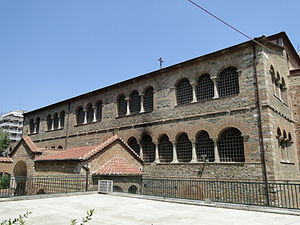- Church of the Acheiropoietos
-
Paleochristian and Byzantine Monuments of Thessalonika * UNESCO World Heritage Site
The Church of the AcheiropoietosCountry Greece Type Cultural Criteria i, ii, iv Reference 456 Region ** Europe and North America Coordinates 40°38′N 22°56′E / 40.633°N 22.933°E Inscription history Inscription 1988 (12th Session) * Name as inscribed on World Heritage List
** Region as classified by UNESCOThe Church of the Acheiropoietos (Greek: [Παναγία] Ἀχειροποίητος) is a 5th-century Byzantine church in the northern Greek city of Thessaloniki. It is located in the city's centre, at Agias Sofias street opposite Makedonomachon square.[1]
History and description
The Acheiropoietos has been dated from its bricks and mosaics to ca. 450–470, making it perhaps the earliest of the city's surviving churches. It was modified in the 7th and again in the 14th–15th centuries. Known as the Panagia Theotokos in Byzantine times, it is dedicated to the Virgin Mary. Its current name is first attested in 1320, presumably after a miraculous acheiropoietos ("not made by hands") icon of Panagia Hodegetria that was housed there.[1][2][3] Byzantine sources also indicate that the city's patron saint, St. Demetrius, was also worshipped in the Acheiropoietos.[3]
The building is a three-aisled basilica, some 28 m wide and 36.5 m long, with a wooden roof. Its eastern end is a semicircular vault, while on the western side a narthex, flanked by towers, and traces of an exonarthex survive. The three aisles are separated by columns, while the two side aisles have galleries above them. At the eastern end of the northern side aisle, a middle Byzantine chapel dedicated to St. Irene is attached. On the northwestern corner of the basilica, the stairway leading to the galleries survives. The current entrance is through a triple-arched opening (tribelon) that connects the narthex with the main nave, while on the southern side there is a monumental entranceway, which probably connected the church with the city's Byzantine-era thoroughfare. Another small adjoining building on the south side has been identified as the church's baptistery. The modern roof is lower than the original, where the section above the central nave was elevated to allow light in.[1][2][4]
The surviving parts of the church's rich original interior decoration include particularly fine 5th-century Ionian capitals from a Constantinopolitan workshop, the green Thessalian marble columns of the tribelon, the original Proconnesian marble pavement of the central nave, and fragments of 5th-century decorative mosaics. Fine but damaged early 13th-century frescoes depicting the Forty Martyrs of Sebaste adorn the southern side. Underneath the north aisle's current pavement, three kayers floor mosaics from an earlier Roman-era bath have been uncovered.[1][5]
After Ottoman conquest of the city in 1430, the Acheiropoietos was the first church to be converted into a mosque, by Sultan Murad II himself. Throughout the Ottoman period, it remained the city's principal mosque under the name Eski Camii ("Old Mosque"). An inscription by Murad survives in the northern colonnade, on the eighth column from the east.[1][3]
References
- ^ a b c d e "Αχειροποίητος" (in Greek), Hellenic Ministry of Culture, http://odysseus.culture.gr/h/2/gh251.jsp?obj_id=6970, retrieved 2010-04-23
- ^ a b Kazhdan, Alexander, ed. (1991), Oxford Dictionary of Byzantium, Oxford University Press, p. 12, ISBN 978-0-19-504652-6
- ^ a b c Kourkoutidou-Nikolaidou, E.; Tourta, A. (1997), Wandering in Byzantine Thessaloniki, Kapon Editions, p. 185, ISBN 960-7254-47-3
- ^ Kourkoutidou-Nikolaidou, E.; Tourta, A. (1997), Wandering in Byzantine Thessaloniki, Kapon Editions, pp. 185–191, ISBN 960-7254-47-3
- ^ Kazhdan, Alexander, ed. (1991), Oxford Dictionary of Byzantium, Oxford University Press, p. 13, ISBN 978-0-19-504652-6
World Heritage Sites in Greece North Aigai · Mount Athos · Paleochristian and Byzantine Monuments of Thessalonica: (Hagios Demetrios, Arch and Tomb of Galerius, Hagia Sophia, Church of Panagia Chalkeon, Church of Saint Nicholas Orphanos, Church of the Holy Apostles, Church of the Acheiropoietos, Monastery of Latomos, Church of Saint Panteleimon)
Central Delphi · Epidaurus · Hosios Loukas · Meteora · Mycenae and Tiryns · Mystras · Old Town of Corfu · Olympia · Temple of Apollo Epicurius at Bassae
Attica Aegean Islands
and CreteCoordinates: 40°38′6.01″N 22°56′53.14″E / 40.6350028°N 22.9480944°E
Categories:- Buildings and structures in Thessaloniki
- Byzantine churches of Thessalonica
- World Heritage Sites in Greece
- 5th-century church buildings
- Mosques converted from churches by the Ottoman Empire
Wikimedia Foundation. 2010.

